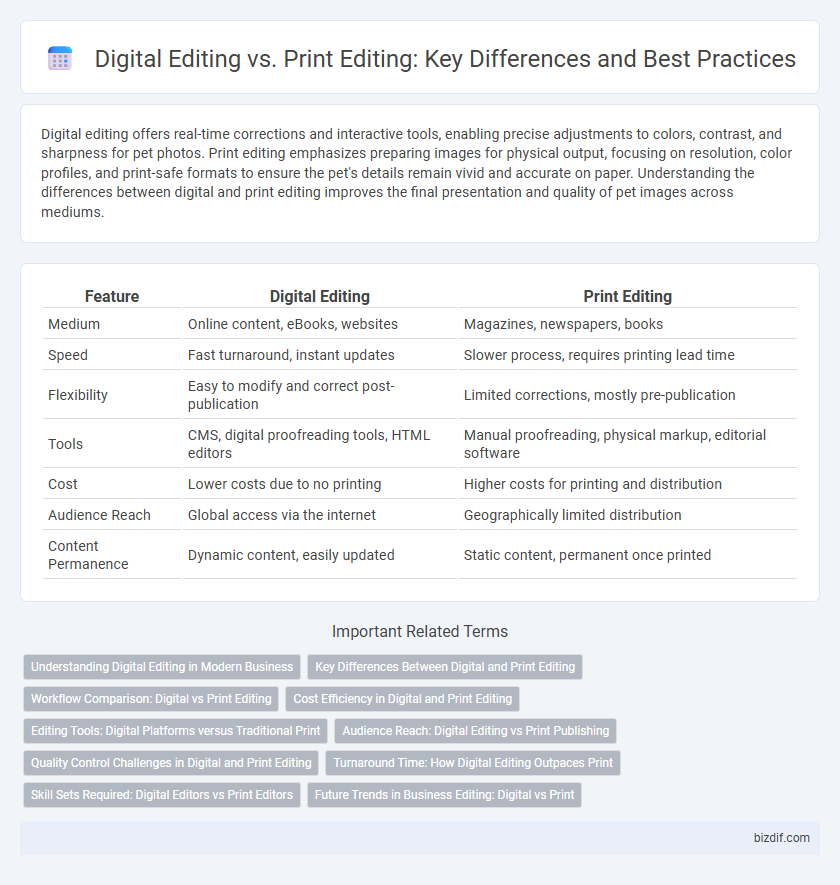Digital editing offers real-time corrections and interactive tools, enabling precise adjustments to colors, contrast, and sharpness for pet photos. Print editing emphasizes preparing images for physical output, focusing on resolution, color profiles, and print-safe formats to ensure the pet's details remain vivid and accurate on paper. Understanding the differences between digital and print editing improves the final presentation and quality of pet images across mediums.
Table of Comparison
| Feature | Digital Editing | Print Editing |
|---|---|---|
| Medium | Online content, eBooks, websites | Magazines, newspapers, books |
| Speed | Fast turnaround, instant updates | Slower process, requires printing lead time |
| Flexibility | Easy to modify and correct post-publication | Limited corrections, mostly pre-publication |
| Tools | CMS, digital proofreading tools, HTML editors | Manual proofreading, physical markup, editorial software |
| Cost | Lower costs due to no printing | Higher costs for printing and distribution |
| Audience Reach | Global access via the internet | Geographically limited distribution |
| Content Permanence | Dynamic content, easily updated | Static content, permanent once printed |
Understanding Digital Editing in Modern Business
Digital editing in modern business leverages advanced software tools to enhance visual and textual content quickly and efficiently, ensuring accuracy and brand consistency across multiple platforms. It enables real-time collaboration, seamless integration with marketing workflows, and faster turnaround times compared to traditional print editing. Emphasizing flexibility and scalability, digital editing supports multimedia content updates that meet evolving consumer demands in dynamic online environments.
Key Differences Between Digital and Print Editing
Digital editing involves rapid, non-linear workflows with real-time collaboration and multimedia integration, maximizing efficiency and flexibility. Print editing emphasizes precision in layout, resolution, and color accuracy to ensure high-quality physical reproduction. Both require distinct technical skills, with digital focusing on SEO and interactivity, while print demands expertise in typography and print production standards.
Workflow Comparison: Digital vs Print Editing
Digital editing workflow leverages non-linear processes, allowing editors to make real-time changes, collaborate remotely, and integrate multimedia elements seamlessly. Print editing follows a linear, methodical workflow involving physical proofs, manual annotations, and sequential approvals to ensure print accuracy. Efficiency in digital editing significantly reduces turnaround time, while print editing demands meticulous attention to detail for final output consistency.
Cost Efficiency in Digital and Print Editing
Digital editing offers significant cost efficiency compared to print editing by eliminating expenses related to physical materials, such as paper, ink, and shipping. The ability to make instant revisions and distribute digital content globally reduces labor and time costs, enhancing overall productivity. Print editing incurs higher costs due to the need for physical proofs, printing setups, and distribution logistics, making it less economical for frequent updates or large-scale projects.
Editing Tools: Digital Platforms versus Traditional Print
Digital editing utilizes advanced software such as Adobe Premiere Pro and Final Cut Pro, offering real-time adjustments, multi-layer editing, and seamless integration with multimedia elements. Traditional print editing relies on manual tools like red pens, physical proof sheets, and markup symbols, emphasizing meticulous text scrutiny and layout accuracy. The efficiency of digital platforms contrasts with the tactile precision of print methods, shaping distinct workflows for editors in each medium.
Audience Reach: Digital Editing vs Print Publishing
Digital editing expands audience reach significantly by enabling instant global access through online platforms and social media, attracting diverse demographics with multimedia integration. In contrast, print editing is limited by physical distribution constraints, targeting local or niche audiences and relying on traditional readership habits. Prioritizing digital editorial strategies enhances engagement analytics, real-time feedback, and content adaptability, crucial for maximizing audience impact.
Quality Control Challenges in Digital and Print Editing
Quality control challenges in digital editing include managing diverse file formats and ensuring consistency across multiple platforms and devices, which often requires advanced software tools and real-time collaboration. Print editing demands rigorous proofing of physical proofs to detect color accuracy, resolution, and layout issues, with limited opportunities for correction post-printing. Both mediums require meticulous attention to detail but differ significantly in their workflows and error rectification processes, impacting the overall quality assurance strategies.
Turnaround Time: How Digital Editing Outpaces Print
Digital editing significantly reduces turnaround time by enabling real-time corrections and instant file sharing, eliminating delays inherent to physical proofs and mailing. Cloud-based collaboration tools streamline the feedback process, allowing multiple editors to work simultaneously on the same document. This acceleration contrasts sharply with print editing's reliance on manual revisions and printing schedules, often extending project completion by days or weeks.
Skill Sets Required: Digital Editors vs Print Editors
Digital editors require proficiency in software tools like Adobe Premiere, Final Cut Pro, and various content management systems, alongside a strong understanding of SEO, multimedia integration, and interactive content optimization. Print editors must excel in copyediting, typesetting, and layout design, with expertise in traditional publishing standards, typography, and color theory for high-quality physical production. Both roles demand strong attention to detail and adaptability, but digital editors emphasize technological fluency while print editors prioritize craftsmanship in tangible media presentation.
Future Trends in Business Editing: Digital vs Print
Future trends in business editing emphasize the rapid growth of digital editing tools powered by AI and cloud technology, offering real-time collaboration, automated proofreading, and data-driven content optimization. Print editing remains important for high-quality, tactile publications but faces declining demand as businesses prioritize cost-efficiency and speed found in digital formats. Integration of augmented reality and multimedia in digital content is reshaping how business editors approach storytelling and audience engagement compared to traditional print methods.
Digital Editing vs Print Editing Infographic

 bizdif.com
bizdif.com